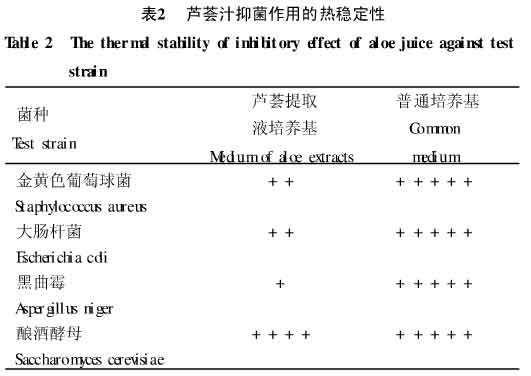Study on Antibacterial Effect of Aloe Extract II: Materials and Methods
Release Date:
2024-06-05
2 Results and analysis
2.1 bacteriostatic effect of aloe juice on the tested bacteria The bacteriostatic effect of aloe juice on the tested bacteria is shown in Table 1.

As can be seen from Table 1, the antibacterial effect of aloe juice on Staphylococcus aureus is leaf root> leaf tip; The antibacterial effect on Escherichia coli is leaf root> leaf tip; The antibacterial effect on Aspergillus niger is leaf root> leaf tip> leaf tip. Aloe juice on Staphylococcus aureus, Escherichia coli, black Qu Lu showed a certain antibacterial effect, the antibacterial effect of wine drunk mother is not very obvious. The results showed that the antibacterial effect of aloe extract was good, and the antibacterial effect on bacteria and mold was comparable to that of sodium benzoate, but the antibacterial effect on yeast was not very obvious, indicating that the sensitivity of eukaryotes to aloe antibacterial substances was not high. In general, the antibacterial effect of aloe juice is better than sodium benzoate.
2.2 Thermal Stability Test Results The results of the thermal stability of the antibacterial effect of aloe juice are shown in Table 2.The stability results are shown in Table 2.

As can be seen from Table 2, for various strains, the thermal stability of the antibacterial effect of aloe juice is good, and even the heat-treated aloe juice still retains good antibacterial ability.
3 Discussions
1) the filter paper method was used to determine the inhibitory effect of aloe juice on a variety of common bacteria, the results vary greatly, which may be due to the low content of effective antibacterial ingredients in natural aloe juice. It is reported that aloe contains emodin, aloe bitterness and aloin 8, of which aloin 8 is the main antibacterial agent, while aloe 8 is a high molecular glycoprotein, which can only be made into 0.026g aloe A white powder per kilogram of aloe. Therefore, when the filter paper method is used, the aloe A adsorbed on the filter paper is very limited, and no obvious antibacterial phenomenon can be seen as a result.
2) It is reported that aloe has different degrees of inhibition to various epidermophytes and dermatophytes, and its antibacterial effect remains to be further studied.
3) the heat resistance of the active ingredients of aloe juice is strong. After high temperature treatment, its antibacterial effect is weakened, but it is not lost. According to this characteristic, appropriate technology can be selected in the processing process to maximize the retention of the active ingredients in aloe juice.
4) The antibacterial effect of aloe vera may be produced by its endosymbiotic fungi. According to the data, 88 strains of endophytic fungi isolated from aloe vera were screened for antifungal active substances, and the results showed that 35 strains of endophytic fungi from aloe vera could inhibit the growth of one or more dermatopathogenic fungi, suggesting that the endophytic fungi population of aloe vera can provide basic conditions and 131 for human beings to find new antigenic. Aloe vera contains a large number of symbiotic fungi, and there is reason to believe that some anthraquinones accumulated in aloe vera, such as aloe vera, may initiate its chemical anti-hoeing.
The secretion of metabolic substances of some fungi, the distribution of various fungi is different, and the concentration distribution of different bactericidal substances may lead to the difference of antibacterial effect of various parts of aloe, but the specific mechanism remains to be further proved by experiments.
5) Aloe juice has a good inhibitory effect on the growth of most of the leather-positive bacteria and leather-negative bacteria, as well as some Shu bacteria, and the required inhibitory concentration is low 9 values, wide range of action, strong thermal stability, its antibacterial effect is slightly lower than sodium benzoate, no obvious inhibitory effect on drunk mother. When aloe vera is mixed with other foods to produce health food, the synergistic effect of antibacterial ingredients and food constituent ingredients remains to be studied, and the medicinal and health functions are in urgent need of application and development.
6) The results showed that the aloe extract had a strong antibacterial effect on a variety of bacteria and molds. However, it does not have an inhibitory effect on wine drunkenness, which shows unique selectivity. Whether aloe can be used as a natural and effective additive by using this unique selectivity remains to be further studied.
News in detail

